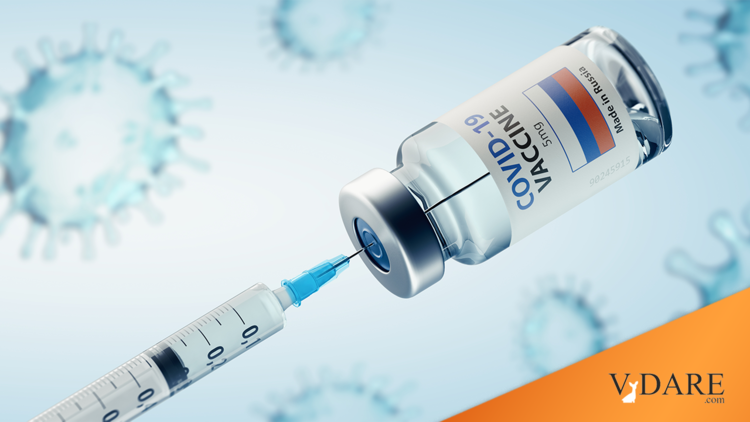
By Steve Sailer
11/25/2020
From Science:
With more data on its COVID-19 vaccine, Russian institute offers new evidence of success
By Kai Kupferschmidt Nov. 24, 2020, 1:00 PM
Joining the flood of press releases announcing positive results from COVID-19 vaccine trials, developers of Russia’s Sputnik V vaccine today reported 91.4% efficacy from a second interim analysis of more than 18,000 people, bolstering a claim the team made on 11 November with scant evidence.
Whereas the initial report rested on a mere 20 cases of COVID-19, with no details on how they were split between vaccinated and placebo groups, the new analysis is based on 39 cases total, eight among the vaccinated group versus 31 in the much smaller placebo arm. …
About 75% got the vaccine, 25% the placebo.
The Sputnik V vaccine, made by the Gamaleya Center for Epidemiology and Microbiology in Moscow, uses adenovirus (Ad) “vectors” to deliver a gene that codes for the surface protein, spike, of SARS-CoV-2, the virus that causes COVID-19. The two-dose scheme begins with an Ad26-spike vaccine and is followed by a booster shot 21 days later that contains Ad5 spike. Gamaleya chose two different adenoviruses because of concerns that immune responses to the same vector could lower the impact of the booster shot.
Another adenovirus vaccine, developed by the University of Oxford and AstraZeneca, reported efficacy data yesterday of 70%. It uses the same adenovirus vector for both the prime and the booster shot. “At the moment, the data released today on the Sputnik vaccine looks to be the best in the field of the adeno-vectored vaccines,” says Ian Jones, a virologist at the University of Reading. The Chinese company CanSino Biologics and pharma giant Johnson & Johnson both also have adenovirus vaccines against COVID-19 in efficacy trials.
Sputnik V is happy to share one of its two human adenoviral vectors with @AstraZeneca to increase the efficacy of AstraZeneca vaccine. Using two different vectors for two vaccine shots will result in higher efficacy than using the same vector for two shots. #SputnikV
— Sputnik V (@sputnikvaccine) November 23, 2020
From iSteve commenter 415 Reasons:
My point is not that the Russian vaccine effort was obviously successful at the time they approved it — clearly the Russian approval was akin to a phase III trial and did not have the same evidentiary bar as FDA approval. But, the Russian vaccine designers made a decision based on this foreseeable outcome to use two different vectors for their prime/boost. The mopes at Oxford/AZ chose not to. There are logistical and other considerations that would lead you to use a single vector, but it turns out those should have been outweighed by considerations of efficacy. That oversight is definitely arrogant! The head of the academic group, Sarah Gilbert, is quoted in the Guardian article, and she still didn’t catch on to the fact that by far the most likely explanation is that they had generated too many anti-vector antibodies for the boost to work. Go back and read her quotes in many hagiographic articles about their vaccine over the spring and summer. These people screwed the pooch! And it seems like their bacon was only saved by a separate logistical mistake they made where they literally administered a mischaracterized drug product to thousands of human volunteers!
Here is one such example but there are many.
Back to Science:
The Russian results presented today are an interim analysis from 18,794 participants 7 days after they received their booster dose. (Only one out of every four received the placebo.)
OK, I’m confused, how long did they wait to see if the vaccine is working?
“Whilst the [COVID-19] case numbers remain small, this is highly effective,” Azra Ghani, an infectious disease epidemiologist at Imperial College London, told the Science Media Centre. The ongoing trial will conduct its next interim analysis after 78 confirmed COVID-19 cases. Overall, trial organizers expect to enroll 40,000 participants.
The new report allays the concerns raised by many vaccine researchers and public health experts when the Sputnik V team made the earlier efficacy claims, according to Jones. “I think the numbers are now significant and I think they do give credence to what they say,” he says. …
One benefit of adenovirus vaccines is they can be stored in standard refrigerators, rather than needing freezers. Charlotte Houldcroft, a virologist at the University of Cambridge, cautions that the latest Russian announcement is yet another instance of “science by press release,” but, she adds, “If the figures are as good as they appear, that’s really promising because this needs a standard cold chain to be rolled out rather than an ultracold chain like the RNA vaccines, and that’s a big plus.”
… Dmitriev said partners in India, South Korea, China, and Brazil are producing the vaccine, which could cost less than $10 a shot. Current agreements would allow for the production of 1 billion doses in 2021, with first doses delivered internationally in January.
So, it sounds like the Russians have a smarter dosing regimen than the similar Oxford-AstraZeneca vaccine, which the Russians are willing to share with the Brits.
And here’s a new Science article on the Chinese vaccine efforts, which mostly use an old technology. No clinical trial data has been released yet, but lots of people in China have been innoculated.
This is a content archive of VDARE.com, which Letitia James forced off of the Internet using lawfare.